The Artful Life
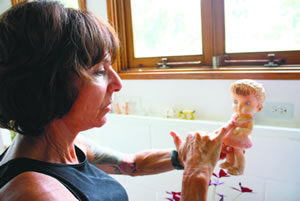
French finds inspiration in seemingly odd places
Sally French says her art ‘is a mirror to a part of humanity,’ combining whimsy and the macabre, sometimes playful, sometimes unsettling, sometimes both at the same time
It’s not every artist who can use childhood images normally associated with safety and comfort to illustrate a tragedy like the radiation from the Fukushima Daiichi nuclear disaster.
But Kalaheo resident Sally French isn’t any ordinary artist.
“My work is a mirror to a part of humanity,” French says. Perhaps that’s why so much of what she surrounds herself with ends up in her work, and vice versa.
The daughter of Carl and Dawn Steinhart, early organizers of Kaua’i Society of Artists and owners of Kahana Ki’i Gallery in Koloa, French now lives in the family house tucked away at the end of a quiet cul-de-sac overlooking the valley.
A canvas in itself, the home and studio are adorned with images consistently used in French’s work, with objets d’art at every turn.
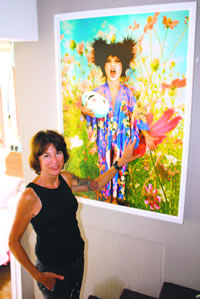
Daughter Aimee is the inspiration for this painting. Amanda C. Gregg photos
An award-winning artist since the ’80s (she won the Director’s Choice Award for the Honolulu Academy of Arts eight times and was given the National Endowment for the Arts Project Grant for The Senses Packet: An Environmental Educational Project for Children in 1974), it’s easy to see what makes French’s art tick. Each piece captures her ability to juxtapose images about contemporary issues, often with whimsy and macabre underpinnings, something galerie 103 owner Bruna Stude describes as “edgy, playful and unsettling.”
Sometimes done by incorporating spheres, cartoons and graffiti, French’s work is anything but simple. There’s an entire world within her image framework, and her home reflects that, too.
An old polka dot chair, hanging rubber tire lei, spray-painted stenciled floors and shelves made of cut-up paintings stacked with deflated rubber balls and doll heads make everything in her surroundings quintessentially hers.
“I have a series of so many different objects that I collect and use and draw,” she says. “It’s how I justify buying all these weird things.”
Holding up one item in her collection, an illustration of an old Dole pineapple advertisement with two cherubic-looking children, French explains her contextual admiration for something she and fellow art students used to think was “so freaking tacky.”
“This is the reason I can draw,” French says, explaining its artist, Barbara Bradley, was one of her instructors at San Francisco Academy of Art after she studied painting and printmaking at Stephens College in Missouri, and the University of Colorado at Boulder.
Showing true appreciation for a collection of objects that some might consider “throwaways” at a garage sale, French keeps her romantic notions of them alive in her art.
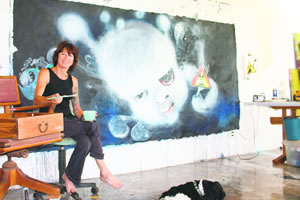
Sally French in her studio that doubles as a sort of private gallery
Ranging in everything from a 1920s-era children’s book of illustrations to several well-loved rubber toys such as an old-school Mickey Mouse purchased at a Parisian flea market French’s home and studio are full of rescued, vintage treasures.
“There was a point I used to say I was an old forgotten cartoon,” she says.
But it’s also in her day-to-day activities that French proves (like her Dadaist predecessors did) that living in the modern world is living life as art.
“Life is perfect in its imperfections and chaos,” she says. “My job is to step out of it momentarily and find the threads that connect us cross-culturally to each other.”
Perhaps that’s why, from picking up part of the wreckage after Hurricane ‘Iniki, French conceived of and helped create the mosaic fish walls and seating at the original site of the first community build for Kamalani Playground at Lydgate in 1993, which was constructed with the help of hundreds of volunteers, children and adults, who embedded thousands of mosaic pieces over several weeks time, resulting in the extensive curved seating and walls at the playground today.
“We used blue roofing tiles gathered from the debris from the Grand Hyatt, Po’ipu,” French says, adding she and artist Melinda Morey gathered tiles that helped create an exquisitely detailed giant gecko curving over the top of a concrete bench. French made a female with fins that has eyeholes for keiki to look through, she says. “We also tumbled colored glass in a tumbler to make highlights, and used marbles for interest.”
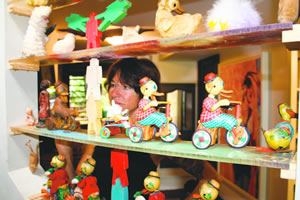
The studio is filled with old dolls and toys
Even making a cup of coffee is an artful experience for French, who roasts her own beans. Steeping a dark, oily broth before foaming some heavy cream, French says the Kenyan beans she uses have been around since “before Christ,” adding with an appreciative sip she’s “gotten a good pull” on this batch.
For those who aren’t familiar with French’s work, it’s a relevant anecdote because connecting with the ambiance is what makes French’s self-described “topical” art extraordinarily referential.
Though rife with pop art and postmodern allusions to contemporary greats such as Takashi Murakami, Andy Warhol and Jeff Koons, French’s eclectic mix of beauty, humor, violence and pop culture is
created with her own trademark cache of images (like circles, graffiti and koi).
Incorporating additional imagery to represent whatever issue she’s romanticizing, identifying with or obsessing over at the moment which, in the case of her current untitled work, revolves around the Fukushima disaster French’s work is hardly formulaic.
And often its meaning evolves.
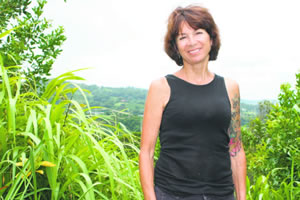
French at home in Koloa. Amanda C. Gregg photos
Describing her current piece, French says she’s still unsure of whether the ghostlike figure in the foreground is the protagonist or antagonist.
“Either she is the radiation itself coming in or she is the goddess warning us, trying to keep it all well,” she says.
Perhaps in reference to the anxiety stemming from unconfirmed reports of the radiation fallout and subsequent effects on those in Japan and even Kaua’i a small, anthropomorphized radiation symbol in the painting appears distressed.
“We are part of this, right now,” French says. “There are people who are trying to stay on top of the information, and there just isn’t a whole lot of information out there. I don’t know, maybe keeping us informed is considered fear mongering.”
Using anthropomorphism is a no-brainer for French, who takes advantage of the seemingly limitless metaphors animals and inanimate objects represent.
Often incorporating bees as an adept commentary on human nature, French says they represent the survivor part of our psyche.
“Bees represent the worker, the little guy, the proletariat, in that it takes masses of them to do what they do,” she says. “They have such a fine, symbolic structure to their culture.”
Of course, there’s also French’s love of spheres, which dominate her work.
“At its most perfect, a sphere will move without any friction,” she says. “Anything round, I’m attracted to innately.”
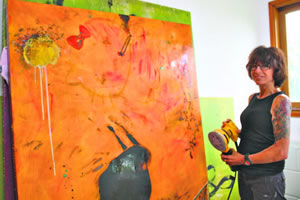
French uses a sander on a previously lacquered piece
That includes bubbles, she says, noting her fascination with their inherent fleeting quality along with their transitory protective membrane. “It’s so delicate, you almost have to hold your breath when you look at one because it could pop at any moment,” she says.
It seems French thinks of her own work in spherical terms, too. “I like to think I bounce off my immediate environment on a personal level and a more universal level,” she says.
Asian art influences are definitive in French’s work as well, as she admires the topical work of Tenmyouya Hisashi, a Japanese artist, and reference books such as Anita Yasuda’s Japanese Children’s Fabrics. French also collects adapted fables like Wang Hsing-pei’s Monkey Subdues the White-Bone Demon, with drawings by Chao Hungpen and Chien Hsiao-Tai.
Describing her work as “layered,” her illustration education is evident throughout her process. Arguably as much about the process as its content, creating her work includes penciling, pouring paint, spray-painting with stencils that she moves while spraying, sanding and coating with a synthetic resin.
“I like for it to have depth,” she says.
French tries to balance everything, especially as she’s not only an artist, but a wife and mother of two.
Though children Aimee and Cory who were both born at home on Moanakai Road in Kapa’a have since flown the nest, French mommies her three dogs, Einstein, Baby and Sunny, and HazMat, her cat, and is still “dazzled” by her husband Dean, whom she met in Honolulu at Frameworks frame shop and later married in the family’s Lawai home.
As far as getting out of her home and studio, French says she loves the island life, which for her means hiking and going up to Koke’e to relax in a cabin, kayaking and swimming. A Pilates student with a penchant for dancing (which explains her killer figure), French says she travels to California about four times a year to help care for the family farm, as well as teach and exhibit art.
Want to see French’s work? View it at galerie 103 in Po’ipu through Sept. 17 or at the Biennial Survey at Honolulu Academy of Arts beginning Jan. 9.



